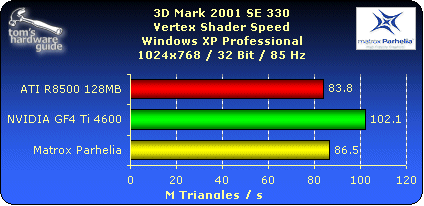Attack Out Of The Blind Spot: Matrox Parhelia-512
Vertex Shader Speed
This test determines the performance of vertex shading units. Parhelia has four vertex shading units, GeForce 4 Ti has two of them, and R8500 only has one.
- Vertex Shader
Vertex shader is like DirectX 7 hardware transformation and lighting, but with a vertex shader, the developer can write a custom transformation and lighting model. While this test demonstrates a vertex shader that does skinning, vertex shaders can be used for countless other types of transformation and lighting, as well. There are 100 skinned characters from game test 3 running around and shooting each other. Vertex shaders can be efficiently emulated in software, therefore this test is run using a software vertex shader, if vertex shaders cannot be run in your graphics hardware.

Parhelia's vertex shader performance is just enough to beat ATI's 8500. However, NVIDIA's GeForce 4 Ti is not so far behind the R8500. In the end, when you consider that it has four vertex shaders, results for the Parhelia are rather disappointing.
Conclusion: With regard to the fill rate, Parhelia manages to shine in the important multi-texturing mode. On the other hand, the polygon performance and the poor pixel shader performance are disappointing. And, even with its Quad Vertex Shader Array, Parhelia is still unable to attain the vertex shader performance of the GeForce 4 Ti 4600, at least not in this test.
Stay on the Cutting Edge
Join the experts who read Tom's Hardware for the inside track on enthusiast PC tech news — and have for over 25 years. We'll send breaking news and in-depth reviews of CPUs, GPUs, AI, maker hardware and more straight to your inbox.
Most Popular

